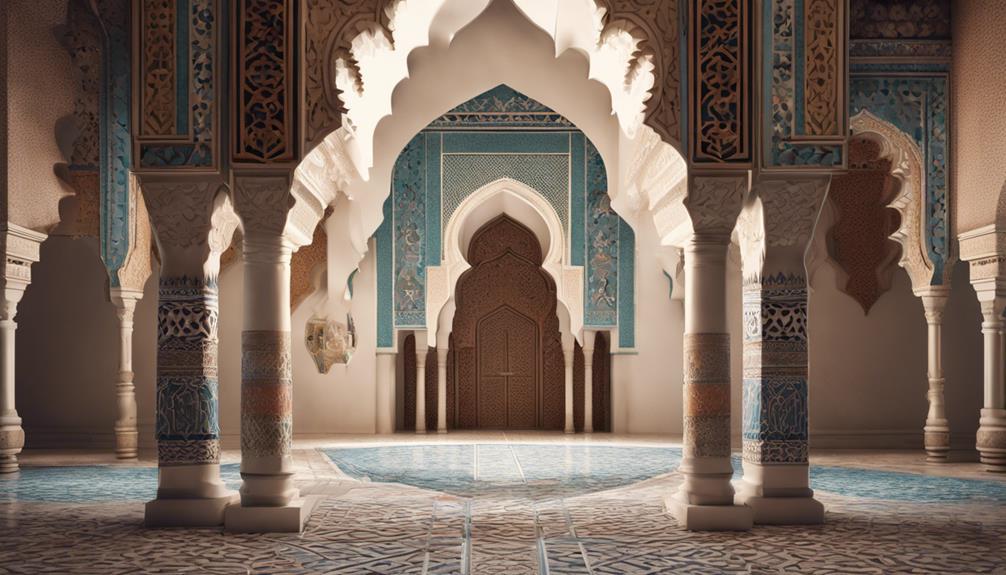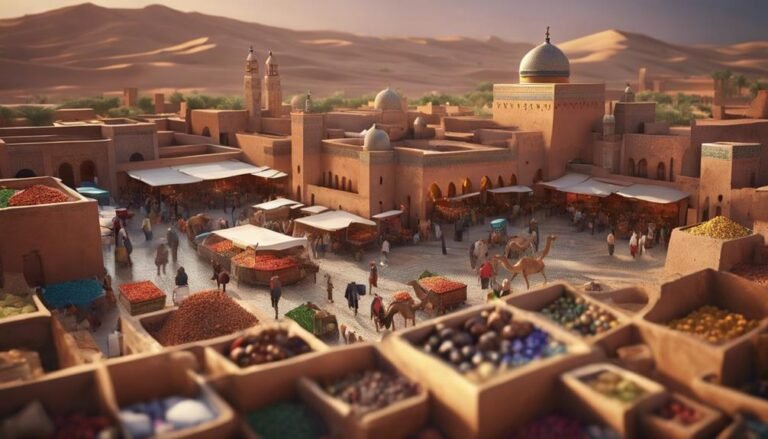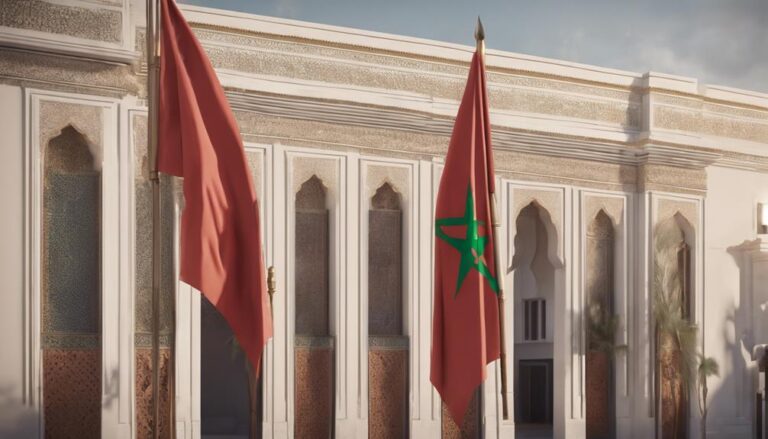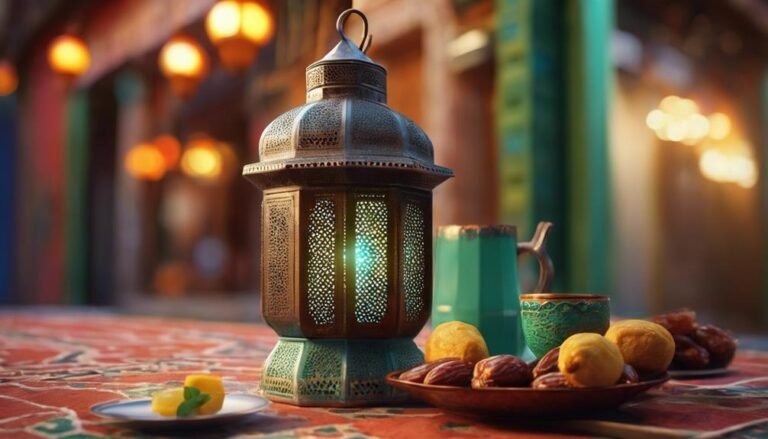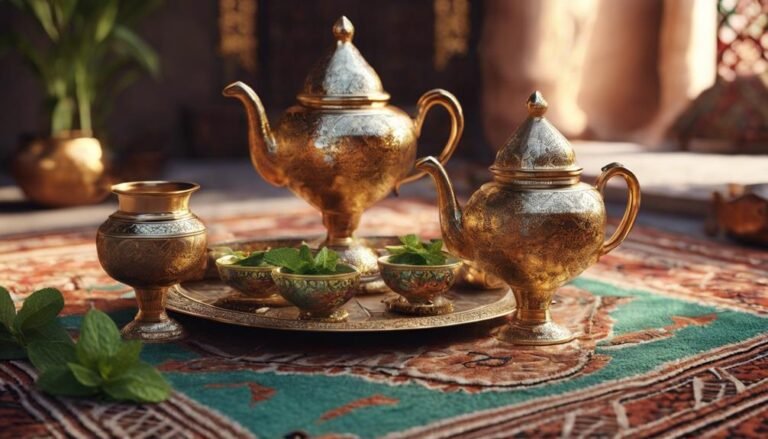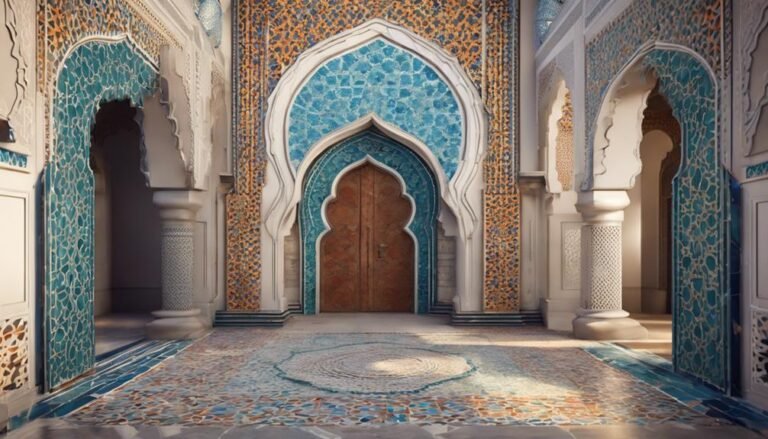Discover the rich history of Morocco, influenced by Carthaginian dominance in North Africa and Roman impact on governance. Islamic conquests led to cultural and architectural advancements by dynasties like the Almoravids. European colonization reshaped Morocco, sparking movements for independence. Under King Mohammed VI, modernization and reforms have enhanced education, women's rights, and the economy. These changes have brought significant societal shifts and economic growth. The intricate tapestry of Morocco's past continues to evolve, reflecting a blend of Arab, Berber, African, and European influences.
Key Takeaways
- Carthaginian and Roman influences shaped early Morocco with trade, governance, and infrastructure.
- Islamic conquests introduced significant dynasties, cultural developments, and architectural innovations.
- Resistance against European colonial rule led to independence struggles and post-colonial challenges.
- Modernization under King Mohammed VI focused on education, women's rights, infrastructure, and economy.
- Reforms in education, women's rights, infrastructure, and economy have led to societal changes and economic growth in Morocco.
Ancient Civilizations in Morocco
Ancient civilizations thrived in Morocco, leaving behind a rich tapestry of historical evidence that sheds light on the region's early societal structures and cultural practices. The influence of the Carthaginians, who were a dominant force in North Africa, played a significant role in shaping Morocco's ancient history. The Carthaginians established trading posts and settlements along the Moroccan coast, contributing to the region's economic and cultural development.
Following the Carthaginian influence, Morocco experienced a period of Roman occupation. The Romans conquered parts of Morocco around 40 CE, incorporating the region into the vast Roman Empire. This occupation brought about significant changes in governance, infrastructure, and urban planning. The Romans built roads, cities, and aqueducts, leaving a lasting architectural legacy in Morocco.
The interplay between Carthaginian influence and Roman occupation in ancient Morocco highlights the region's strategic importance in the ancient world. These interactions laid the groundwork for future developments and cultural exchanges that would continue to shape Morocco's history.
Islamic Conquest and Dynasties
The Islamic conquests in Morocco marked a pivotal moment in the country's history, leading to the establishment of significant dynasties.
The Umayyad and Abbasid rules brought about cultural and architectural developments, shaping the region's identity.
Subsequently, the Almoravid and Almohad dynasties played vital roles in the political landscape and contributed to the rich tapestry of Moroccan history.
Early Islamic Conquests
During the early Islamic Conquests in Morocco, various Islamic dynasties established their rule and left a significant impact on the region's history and culture.
The Arab expansion into Morocco encountered significant resistance from the indigenous Berber populations. Despite initial confrontations, a blend of Arab and Berber cultures emerged, influencing the language, architecture, and traditions of the region.
The Umayyad Caliphate's rule in Morocco brought administrative changes and the introduction of Islam, laying the foundation for future Islamic governance in the area.
The establishment of various Islamic dynasties, such as the Idrisid and the Almoravid, marked a shift in the political landscape of Morocco, shaping its identity for centuries to come.
These conquests played an important role in the formation of Morocco's diverse and rich historical tapestry.
Umayyad and Abbasid Rule
Upon their conquests in Morocco, the Umayyad and Abbasid dynasties implemented significant administrative reforms, shaping the region's governance and cultural landscape.
The Umayyads introduced architectural marvels like the Great Mosque of Cordoba, which influenced Umayyad architecture in Morocco, characterized by intricate geometric patterns and horseshoe arches.
Abbasid influence brought advancements in various fields such as science, mathematics, and literature, enriching Moroccan society. The Abbasids also established a centralized government system with efficient bureaucracy and encouraged trade, leading to economic prosperity in Morocco.
The blend of Umayyad architectural styles and Abbasid intellectual achievements during their rule left a lasting impact on Morocco's culture and governance, laying the foundation for future dynasties to build upon.
Almoravid and Almohad Dynasties
Shaping the course of Islamic conquest and rule in Morocco, the Almoravid and Almohad dynasties emerged as formidable powers in North Africa during the medieval period. Religious conflicts played a significant role in the rise of these dynasties, as they sought to establish and maintain Islamic orthodoxy within their domains.
The Almoravids, originating from the Sahara Desert region, expanded through military conquests, uniting North Africa and Spain under their rule. Their successors, the Almohads, continued this trend of military expansion, further consolidating their control over the region. However, despite their military successes, internal strife and external pressures eventually led to the decline of both dynasties, paving the way for new powers to emerge in the region.
European Colonial Rule
When examining European colonial rule in Morocco, it's essential to analyze the lasting impacts it had on the nation's social, political, and economic structures.
The resistance movements that emerged during this period played a significant role in shaping Morocco's path towards independence.
Understanding the complex dynamics of colonization and the subsequent fight for freedom provides valuable insights into Morocco's historical trajectory.
Impact of Colonization
During the era of European colonial rule, Morocco underwent significant transformations that reshaped its societal structure, economy, and political landscape.
The colonial legacy left by countries such as France and Spain had a lasting impact on Morocco's development. The economic system was altered to benefit the colonizers, leading to the exploitation of resources and labor. Social structures were disrupted as traditional hierarchies were undermined, creating new power dynamics.
Post-colonial challenges emerged as Morocco struggled to regain independence and establish its own identity. The political landscape was marked by a struggle for self-governance and the need to overcome the legacy of colonization.
These challenges continue to shape Morocco's path towards progress and development in the modern era.
Resistance and Independence
The resistance against European colonial rule in Morocco was characterized by a fervent push for independence and a fierce determination to reclaim autonomy from foreign powers. Resistance movements led by nationalist leaders emerged, employing revolutionary tactics in their anti-colonial struggles. Figures like Allal al-Fassi and Mohamed Zerktouni played pivotal roles in organizing resistance against European powers.
The nationalist movement gained momentum through protests, strikes, and political activism aimed at ousting colonial rule. These efforts culminated in Morocco's independence in 1956, marking a significant victory for the country's sovereignty and self-governance.
The legacy of the resistance against European colonial rule serves as a reminder of the enduring spirit of the Moroccan people in their fight for freedom and independence.
Struggle for Independence
Amidst escalating tensions and dissatisfaction, Moroccans initiated a determined struggle for independence from colonial rule. The independence movements in Morocco were characterized by a diverse array of nationalist leaders who played pivotal roles in mobilizing the population and advocating for self-governance. Figures like Allal al-Fassi, a prominent nationalist leader and founder of the Istiqlal Party, emerged as key proponents of Moroccan independence, calling for an end to French and Spanish influence in the region.
These independence movements gained momentum throughout the mid-20th century, fueled by widespread discontent with colonial policies and aspirations for self-determination. The establishment of organizations like the Moroccan Nationalist Action Party (PAN) and the emergence of influential voices such as Sultan Mohammed V further galvanized the push for independence.
Moroccan nationalists engaged in various forms of resistance, including protests, strikes, and civil disobedience, to challenge colonial authorities and assert their right to sovereignty. The struggle for independence in Morocco culminated in 1956 when the country finally gained independence from French and Spanish colonial rule, marking a significant milestone in Moroccan history.
Modernization and Reforms
In the era of modernization and reforms in Morocco, significant changes were implemented to transform and advance the country's societal and economic structures. Under the leadership of King Mohammed VI, Morocco has undertaken a series of modernization initiatives aimed at enhancing various aspects of society. These reforms have touched upon areas such as education, women's rights, infrastructure, and economic development. The government has been actively working towards creating a more inclusive and progressive society by promoting gender equality, improving education standards, and investing in infrastructure projects to boost economic growth.
To illustrate the impact of modernization and reforms in Morocco, the table below provides a summary of key changes implemented in different sectors:
| Sector | Reform Description | Impact |
|---|---|---|
| Education | Introduction of modern teaching methods | Improved literacy rates and quality education |
| Women's Rights | Enactment of laws promoting gender equality | Increased participation of women in workforce |
| Infrastructure | Investment in transportation and energy projects | Enhanced connectivity and energy efficiency |
| Economy | Implementation of economic diversification policies | Stimulated economic growth and job creation |
These reforms have not only brought about modernization but have also led to significant societal changes, paving the way for a more prosperous and inclusive Morocco.
Contemporary Political Landscape
With the implementation of modernization and reforms in various sectors, the current political landscape in Morocco reflects a dynamic interplay of evolving ideologies and power dynamics. Political reforms have been a significant feature in shaping the contemporary political scene. The country has seen efforts to increase transparency, enhance governance, and promote participation in decision-making processes. These reforms aim to address societal demands for greater accountability and responsiveness from the government.
Social movements have also played an important role in shaping the political landscape of Morocco. Protests and demonstrations have been instrumental in pushing for change and highlighting key issues such as human rights, economic inequality, and political freedoms. These movements have been a driving force behind some of the recent political reforms, showcasing the active citizenship and engagement of the Moroccan population.
Cultural Heritage and Diversity
Cultural heritage and diversity in Morocco showcase a rich tapestry of traditions and influences that have shaped the nation's identity over centuries.
- Cultural Preservation: Morocco diligently works towards safeguarding its cultural heritage through initiatives like the restoration of historic sites and the promotion of traditional arts and crafts.
- Ethnic Traditions: The diverse ethnic groups in Morocco, including the Amazigh (Berber) people, Arabs, and sub-Saharan Africans, contribute to the country's unique cultural landscape.
- Influences: Morocco's cultural heritage is a blend of Arab, Berber, African, and European influences, reflecting its history of trade, conquest, and migration.
- Celebrations and Festivals: The country's vibrant festivals, such as the Fes Festival of World Sacred Music and the Marrakech International Film Festival, highlight Morocco's cultural richness and diversity.
Morocco's commitment to cultural preservation, coupled with its embrace of diverse ethnic traditions, underscores the importance of heritage in shaping the country's national identity and fostering a sense of unity among its people.
Conclusion
Overall, the history of Morocco is a rich tapestry woven with ancient civilizations, Islamic conquests, European colonial rule, and a struggle for independence. The country has seen modernization and reforms, shaping its contemporary political landscape.
With a diverse cultural heritage, Morocco continues to thrive and evolve. Just like the intricate patterns in a Moroccan rug, the country's history is a beautiful mosaic of resilience, traditions, and progress.

The Editorial Team is a passionate group of Morocco enthusiasts dedicated to sharing the beauty, culture, and wonders of this captivating country. With diverse backgrounds and a deep love for travel, we strive to bring you engaging and informative content that inspires your Moroccan adventures. From uncovering hidden gems and sharing local insights to exploring mouthwatering cuisine and showcasing the vibrant lifestyle, our team is committed to providing you with valuable resources and exciting stories that enhance your exploration of Morocco. Join us on this journey as we celebrate the rich heritage and unforgettable experiences that make Morocco truly special.

